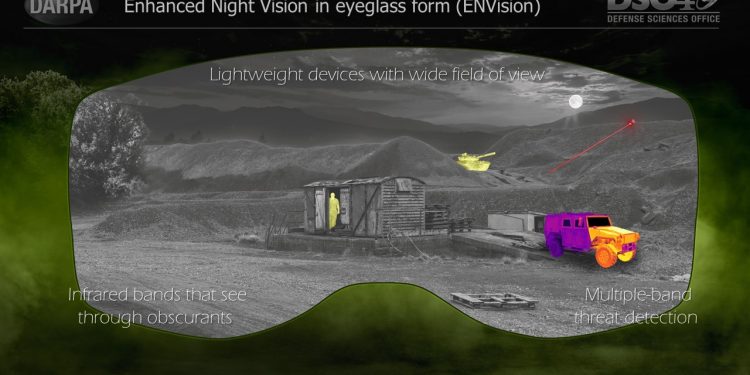DARPA has selected 10 industry and university research teams for the Enhanced Night Vision in Eyeglass Form (ENVision) program.
Current night vision (NV) systems are bulky and heavy, resulting in a significant torque on the wearer’s neck. This torque greatly limits the wearer’s agility and often leads to chronic injury over prolonged use. Additionally, existing NV devices only provide a narrow field of view (FOV) and are limited to the near-infrared (IR) spectral bands, greatly limiting situational awareness in varied night conditions.
ENVision seeks to leverage recent advances in planar optics and transduction materials to develop NV systems that don’t require bulky image intensifiers, provide wider FOV, offer enhanced visual access across infrared bands, and are lightweight to reduce neck strain caused by today’s technology.
Five teams were selected in each of two technical areas.
In the first technical area, performers are tasked to develop multi-band, wide FOV planar optics and planar image intensifiers to demonstrate advanced night vision systems imposing near-zero torque on the wearer. The following research teams will work to develop these capabilities:
- Physical Sciences, Inc., Meta-Optic InfraRed-Enhancing (MOIRE) Eyewear
- Raytheon Technologies Research Center, Thin-film Avalanche Up-conversion and Imaging System (TAUIS)
- SRI International, Advanced Meta-optic and Planar-image-intensifier-system for Enhanced Dual-band NVG
- University of California-San Diego, novel low-noise gain processes for enhanced upconversion
- University of Washington, Scalable Hybrid-optics Integrated Night-vision Eyeglass (SHINE)
In the second technical area, teams will explore new methods to amplify photonic up-conversion processes from any infrared band to visible light to enable future “intensifier-free” night vision systems. Teams selected for this technical area are:
Raytheon BBN, III-nitride flat optics device for broadband infrared to visible nonlinear conversion
Stanford University, excitonic circuitry enables nightglow up-conversion
University of Central Florida, coherent up-conversion by broadband extreme-confinement metamaterials
University of Melbourne, efficient infrared-to-visible up-conversion with an upconverting nanoparticle micro laser
University of Pennsylvania, broadband efficient up-conversion through bound states in the continuum in LiNbO3 photonic crystals
“The teams in the first technical area are developing technologies that could drastically reduce the bulk and volume of objective, intensifier, and eyepiece of a night vision system,” said Rohith Chandrasekar, ENVision program manager in DARPA’s Defense Sciences Office.
“Teams in the second technical area are exploring ways to directly upconvert and amplify light from the infrared to the visible using new materials and up-conversion processes. These efforts could potentially lead to all-optical night vision systems in the future without the need for image intensifiers.”











